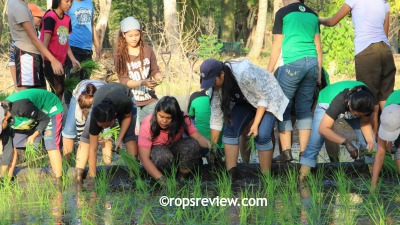Various methods of planting are practiced in crop farming.
These can be put under broad classifications such as direct seeding vs. transplanting, direct planting vs. indirect planting, and manual vs. mechanized planting.
This page is about the first alternative methods as applied mainly to crops that can be grown from seeds.
Direct Seeding vs. Transplanting
In general, a farmer who intends to raise a crop has to choose between these two methods of planting: direct seeding and transplanting.
To briefly distinguish, direct seeding means planting at the crop area with the use of seeds while transplanting is planting with the use of pre-grown seedlings or plants that had been propagated from seeds.
Crop area is here meant to refer to any space intended for the growing of crops for the purpose of harvesting some products

Therefore, the two methods of planting can also be described as direct planting and indirect planting.
For transplanting, it is indirect because the seeds are not immediately sown on the field.
Instead, these seeds are first used to raise seedlings in pots or in any temporary place, and only when they reach the right age are they outplanted.
The actual field planting may be accomplished either manually or by mechanical means.
Where These Methods of Planting are More Preferred
First, let it be clarified that crop plants that are normally grown from seeds can also be grown from seedlings, theoretically at least.
In fact, corn (maize) grains at the milking stage can be used as raw material to produce seedlings.
By tissue culture techniques, the embryo can be extracted and used as a propagule.
Its application for commercial grain production, however, is another matter.
Whether to choose direct seeding or transplanting for field planting depends on many factors. Among others, these include:
(1) the crop species to be grown,
(2) ease in planting and survival rate,
(3) farmer’s familiarity,
(4) timeliness,
(5) financial capability of the farmer,
and (6) return on investment.
Consider corn.
Why is it grown from seeds (grains) all throughout the world?
First, because corn cannot be propagated using other plant parts.
It is likewise presumed that only a very few are aware that immature corn seeds can be used to produce potted seedlings which in turn can be outplanted.
The supporting technology is not even available, indicating perhaps that producing seedlings for commercial grain production is too farfetched.
Crop Examples
Even if the technology for the production of pre-grown seedlings has been established, it may be too costly and may just cause delay.
Indeed, why experiment on the use of seedlings when corn can be readily grown from seeds and has been for thousands of years?
Even back in 1588 when Thomas Hariot of England came to what is now the United States of America, the native Indians were already planting corn with seeds in well-spaced hills! (Hariot 1588).
It is different from rice.
Both methods of planting are applicable and have, likewise, been proven effective and adaptable to farmers.
Direct seeding is common in cereals such as upland rice, corn, sorghum, and millets; pulses such as soybean, peanut, and mungbean; large-seeded vegetables like squash and other cucurbits including melons, root vegetables such as carrot and radish, many leafy vegetables, okra or lady’s finger (Abelmoschus esculentus), and bitter gourd (Momordica charantia).
Examples of crops that are commonly transplanted are small-seeded vegetables like the solanaceous plant’s tomato, eggplant, and peppers, ornamental crops, fruit trees, and many perennial crops including palms such as coconut and African oil palm (Elaeis guineensis).
Examples of crops where both direct seeding and transplanting methods of planting are commonly used are lowland rice and the Cruciferous (Brassica) vegetables cabbage, pechay and mustard, and lettuce.
Although pregrown seedlings are commonly used in the establishment of coconut plantations, unsprouted seed nuts can also be directly planted.
Do you know that some seeds used in plant propagation are not entirely seeds? Click to read.
More About Direct Seeding and Transplanting Methods of Planting
The term direct seeding, also called direct sowing, is also used to refer to the planting of seedpieces or underground vegetative planting materials directly into the soil as in potato (Solanum tuberosum).
However, direct seeding may not be interpreted literally as “direct” as in corn.
In rice, the seeds are pretreated to break dormancy, soaked in water, and incubated to initiate germination immediately before drilling or broadcasting on puddled soil.
In contrast, transplanting, sometimes called replanting, is a method of planting that only requires the use of pre-grown plants, or seedlings, or vegetatively propagated clones for field planting.
It does not distinguish as to the source of the planting material, that is, whether from seed or from vegetative parts of plants.
In addition, the transplanting method of planting is also used to refer to the practice of replanting in which an already established plant in one location is moved elsewhere.
Transplanting is also convenient with a few plants that can be transferred with a ball of soil around the roots.
Heavy-duty mechanical transplanters have been invented for large trees.
In some vegetables, it is common to prick seedlings from the seedbed and transplant them bareroot to the garden plot.
In perennial species like coffee at a time when rainfall has become frequent and light is not intense, wildlings have been outplanted immediately after uprooting.
In fact, bare-root transplanting can apply even in mature mango trees (Click here to read).
Memory Check: Can bamboo be grown from seed?
LITERATURE CITED
HARIOT T. 1588. A brief and true report of the new found land of Virginia. Retrieved May 29, 2015, from http://digitalcommons.unl.edu/cgi/viewcontent.cgi?article=1020&context;=etas.

Thank you for helping in my activity about Field crops.
This helps a lot thanks for the information
thanks its clear and well explained
are there any other methods of planting crops other than direct seeding and transplanting